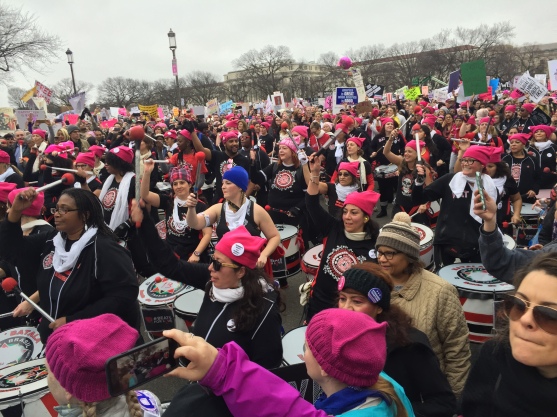by Summer Zickefoose
On January 21st, 2017, over 4 million people marched in Washington D.C., in every major city in the US and in over 50 countries world-wide[1]. These marches were women-led[2] and equal rights were front and center, but by no means the exclusive issue for marchers as LGBTQ rights, social justice, immigration, labor, health care and the environment were among the many reasons marchers came out. While not everyone wore a pink pussyhat, the number that did made them the most powerful unified symbol of the marches. Pink, soft, warm, subtlety cat-eared and shouting loudly without saying a word. They added an additional layer of unity on top of the thousands crowded together in support and collective resistance.

The Pussyhat Project, co-founded by Krista Suh and Jayna Zweiman with help from Aurora Lady (she created all the Pussyhat artwork) and Kat Coyle (she designed the Pussy Power Hat pattern), was initiated in November following the election. The rapid pace at which the marches were organized and the hat patterns were downloaded, shared, knit and crocheted is awe-inspiring. And yes, they were made by hand, in America. Also, in Mexico, Canada, Nigeria, Belarus, Saudi Arabia, Thailand and in every country where a march was held and probably some countries were there were no marches. Many cities reported shortages of pink yarn.[3] It was an rapid hat make-a-thon. I did not fully appreciate how extensive the project was until I saw how many people were wearing them on Saturday, January 21st, and later in the images of other, larger marches with seas of pink.

The mission of the project was to provide the people of the Women’s March on Washington D.C. a means to make a unique collective visual statement and to provide those who could not be physically present at the march a way to represent themselves and support women’s rights.[4] My own hat arrived two days before the march, from my mother’s best friend who was marching in another state. Amongst the group I marched with, there were hats made by friends who were not able to march but wanted to participate and we were given other hats by a group of women we met who were handing them out. The many gestures wrapped into this project – that of crafting these hats by hand, distributing them freely and wearing them symbolically, represent so much of the spirit of the march itself. I hope these acts of community support, political involvement, the willingness to make and work and do individually to contribute to the collective will prove themselves as successful as this project and the marches. I also hope there are more shortages of pink yarn in the future.
[1] “Sister Marches,” Women’s March on Washington, accessed January 28, 2017, https://www.womensmarch.com/sisters.
[2] Gloria Steinem, “Why women are marching on Washington,” The Boston Globe (January 19, 2017), https://www.bostonglobe.com/opinion/2017/01/19/why-women-are-marching-washington/mY0XZLDS4pu57uVk6ou4EJ/story.html.
[3] Nicole Brodeur, “Pussyhat production causes run on pink yarn,” The Seattle Times (January 10, 2017), http://www.seattletimes.com/life/lifestyle/pussyhat-production-causes-run-on-pink-yarn/.
[4] “Mission,” Pussyhat Project, accessed January 28, 2017, https://www.pussyhatproject.com/mission/.